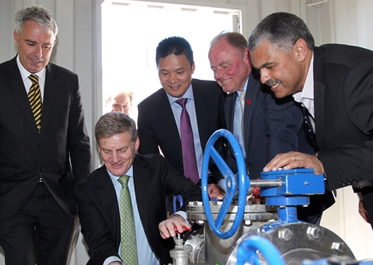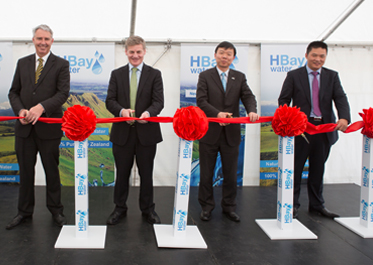
Hastings joint venture is creating jobs for Bay
PHOTO: Hastings mayor Lawrence Yule (L) splashes down with Deputy Prime Minister Bill English, NZ Miracle Water CEO Xinghong Ju, Tukituki MP Craig Foss and production manager Gavin Adams at the opening of New Zealand Miracle Water’s $20 million water bottling plant. Photo / Duncan Brown
By Patrick O’Sullivan, Business Editor for Hawke’s Bay Today
Click here to read this article on New Zealand Herald
A $20 million water bottling plant near Hastings, which was officially opened yesterday, will export water extracted from a 300m aquifer to Asia and the Middle East, as well as employing 26 people.
This number will climb to 80 people as production increases to the Elwood Rd business’ consented 900,000 cubic metres of water – 0.6 per cent of water allocated by the Hawke’s Bay Regional Council.
At full production New Zealand Miracle Water joint venture with logistics company Tomoana Warehousing will make 90 truck deliveries a day of branded HBay Water to Napier Port.
Initially 7 litre pouches are being produced for overseas water machines but NZ Miracle Water CEO Xinghong Ju plans to use it with infant formula.
With a ceramic aggregate/shipping business in Qingdao he also supplied infant formula until the Chinese government limited the number of suppliers.
The father of three, with one on the way, said it was always his vision to combine both New Zealand products.
Hawke’s Bay water was chosen because it was pure, had low mineral content and tasted good.
Deputy Prime Minister and Minister of Finance Bill English unveiled a plaque to mark the occasion yesterday.
He said it was good to see a tangible example of the close relationship between China and New Zealand.
“This investment and the understanding of what New Zealand can offer is one of the by-products of the free-trade agreement with China and the positive political relationship that has gone with that,” he said.
“In the last few weeks we have seen the signing of the TPP and in 10 or 15 years’ time, when the real value of that is fully understood, we will be back in Hawke’s Bay acknowledging investment from different markets ” Mexico, Canada, Peru and the United States.
“What goes with this kind of investment is our ability to sell our products into vast, growing wealthy markets.
“For example the TPP is removing tariffs for apples into Mexico. New Zealand currently sells 500 tonnes of apples to Mexico and the United States sells 300,000 tonnes of apples to Mexico. And American apples are awful.
“Investment in those kind of agreements is going to allow us to sell potentially hundreds of thousands of tonnes to Mexico.
“This investment is good for Hawke’s Bay because it underpins the resource base here and by working together we realise the value.”
Guardians of the Aquifer spokesman Ken Keys said the science of the aquifer was poorly understood.
“There is fear of the repercussions of drawing off so much water,” he said.
“So little is known about it and the regional council have not investigated the science of the whole hydrology to any great level, which is worrying because we are so dependent on it. There are a lot of questions to be answered.”
Tomoana Warehousing’s owner Trevor Taylor said before the plant was built the bore was run at twice the consented rate by an independent party “flooding the whole paddock for three days” and no effect was measured on neighbouring bores.
A report by Economic Solutions estimated a regional Gross Domestic Product impact from NZ Miracle Water of $11 million, expected to grow exponentially.
Meanwhile the government’s 2015 Regional Economic Activity Report, released this week, highlights water security and management as key to the region’s economic outlook.
“Improvements in irrigation capacity and water management will make the primary sector more resilient to droughts and increase capacity for dairy farming, horticulture, viticulture, and arable cropping,” it said.
Hawke’s Bay Hawke’s Bay had a relatively low mean annual household income ($73,200) compared with the rest of New Zealand ($89,000). Contributing factors were the dominance of lower-earning primary industries and a high proportion of unskilled labour, even though the region performed well with educational attainment rates.

